Coulda, Shoulda, Woulda - Escaping the 'What If' Trap
1 Comment
|
About bcI'm a teacher, coach, and parent seeking excellence while defining success on my own terms. Archives
April 2024
Categories |


 RSS Feed
RSS Feed